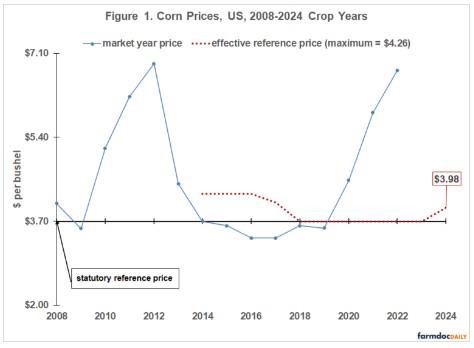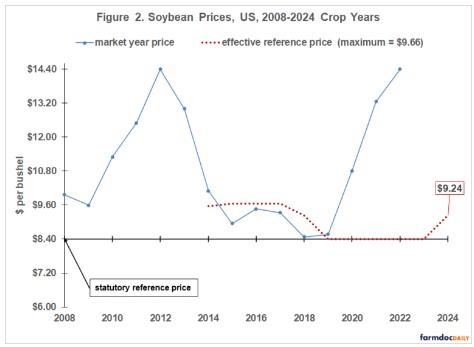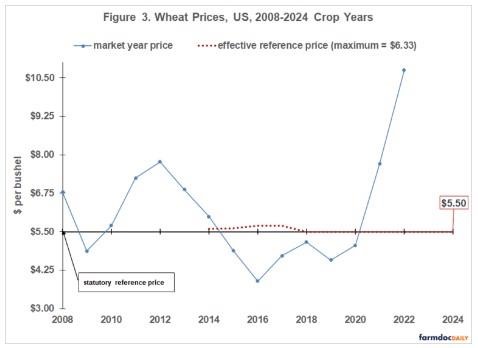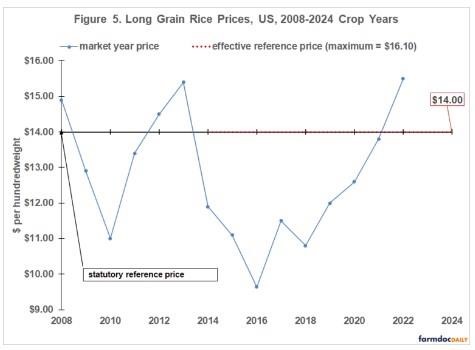By Carl Zulauf
Department of Agricultural, Environmental and Development Economics
Ohio State University
Gary Schnitkey and Jonathan Coppess et.al
Department of Agricultural and Consumer Economics
University of Illinois
The Agriculture Improvement Act of 2018 initiated an escalator clause for the farm safety net’s reference price. We evaluate how this escalator would have influenced payments by the Price Loss Coverage (PLC) program from 2014 forward, the first crop year PLC was implemented. Five crops with a range of relationships between reference prices and market prices are examined: corn, soybeans, wheat, sorghum, and long grain rice. The escalator would have increased reference prices and thus PLC payment rates for sorghum, wheat, and, especially corn and soybeans over the 2014 farm bill crop years of 2014-2018. There is a very good likelihood that the escalator will increase corn, soybean, and sorghum reference prices starting with the 2024 crop year. The reference price escalator reduces the need to raise statutory reference prices.
Overview – Reference Price Escalator
The effective reference price for a crop year is the higher of (a) the statutory reference price stated in the 2018 farm bill or (b) 85% of the Olympic average price (excludes high and low price) for the 5 most recent completed crop years but capped at 115% of the statutory reference price (US Congress, 2018). Since the reference price escalator uses prices for completed crop years, the calculation window for the upcoming 2022 crop year is the 2016-2020 crop years. More broadly, the calculation window is the 5 crop years that are 2 to 7 years prior to the crop year for which the escalator is being calculated. Given the 85% factor in the escalator calculation, average market price during the calculation window must exceed the statutory reference price by more than 15% for the escalator to increase the reference price. Since its authorization in the 2018 farm bill, the escalator has increased the reference price in at least one crop year for large and small chickpeas, crambe, lentils, mustard, rapeseed, Japonica rice, and sesame.
Analysis
The 5 crops examined in this article (corn, long grain rice, sorghum, soybeans, and wheat) have a range of relationships between market price, thus the price escalator, and the statutory reference price (farmdoc daily February 21, 2019). At the time the 2018 farm bill was enacted soybeans had the highest market price relative to its reference price among these crops. Sorghum and especially long grain rice had the lowest market price relative to statutory reference price. Corn and wheat were in between. The first reference price escalator calculation window used in this analysis is the 2008-2012 crop years for the 2014 crop year, or the first year of the 2014 farm bill. This starting point allows an analysis of how the reference price escalator would have performed following the extended crop prosperity period of 2007-2013. The last 5-year calculation window in this analysis is 2018-2022 for the 2024 crop year. Reference prices for the 2023 and 2024 crop years are forecasts based on the assumption that the prices in the May 2022 WASDE (World Agriculture Supply and Demand Estimates) are realized. Prices for the 2008-2020 crop years are from Quick Stats (USDA, NASS (US Department of Agriculture, National Agricultural Statistics Service)).
Findings – Historical
The escalator would have resulted in higher corn and soybean reference prices for every year during the 2014 farm bill period except for corn in 2018 (see Figures 1 and 2). The reference price was at its maximum value (i.e. at its 15% cap) in the 2014-2016 crop years for corn (increase of $0.56 / bushel) and in the 2015-2017 crop years for soybeans (increase of $1.26 / bushel). Wheat and sorghum’s reference prices were higher for the 2014-2017 crop years (see Figures 3 and 4). Sorghum’s reference price was at its maximum value only in 2014 (increase of $0.59 / bushel) while wheat’s reference price never was at its maximum value (largest increase was $0.20 / bushel in 2016). The escalator never increased the reference price for long grain rice. Its reference price throughout the 2014 farm bill period was its statutory reference price (see Figure 5). These notable historical impacts are consistent with the previously-discussed differences across the five crops in the relationship between market price and statutory reference price.





Findings – Forecast
The price escalator will not increase the reference price for any of the five crops until the 2024 crop year, assuming the crop year prices in the May 2022 WASDE are’ realized (see Figure 1 – 5). The 2024 reference prices for soybeans, corn, and sorghum will increase, respectively, 10% ($0.87 / bushel), 8% ($0.29 / bushel), and 3% ($0.11 / bushel). The escalator does not increase the wheat or long grain rice reference price. The forecasted differences in the 2024 impact of the reference price escalator are consistent with its historical impact had it been authorized in the 2014 farm bill.
Summary Observations
The 2018 farm bill (US Congress, 2018) does not address the reason for creating the reference price escalator. Whatever the reason, it better aligns reference prices with market prices by increasing a program commodity’s reference price when average market price over a prior 5-year period exceeds the program commodity’s statutory reference price by more than 15%.
Had the reference price escalator existed in the 2014 farm bill, it would have materially increased payments by PLC (Price Loss Coverage) for some program commodities, including corn and soybeans. The reference price escalator thus could have changed farmers’ one time program decision under the 2014 farm bill.
The reference price escalator is likely to increase the reference price over the next farm bill period for a number of program commodities, including corn and soybeans. It thus could materially increase the budget for the farm safety net in the next farm bill.
The likely increase in reference prices due to the reference price escalator during the 2024 farm bill reduces the need to raise statutory reference prices, a topic generating considerable discussion.
The reference price escalator imparts to PLC an important feature of the ARC (Agriculture Risk Coverage) program, the ability for support to adjust upward when market revenue moves notably higher for a period of at least 3 years in length. A forthcoming article will compare the currently projected reference price to current projections of the ARC price for the 2024 crop year.
Source : illinois.edu